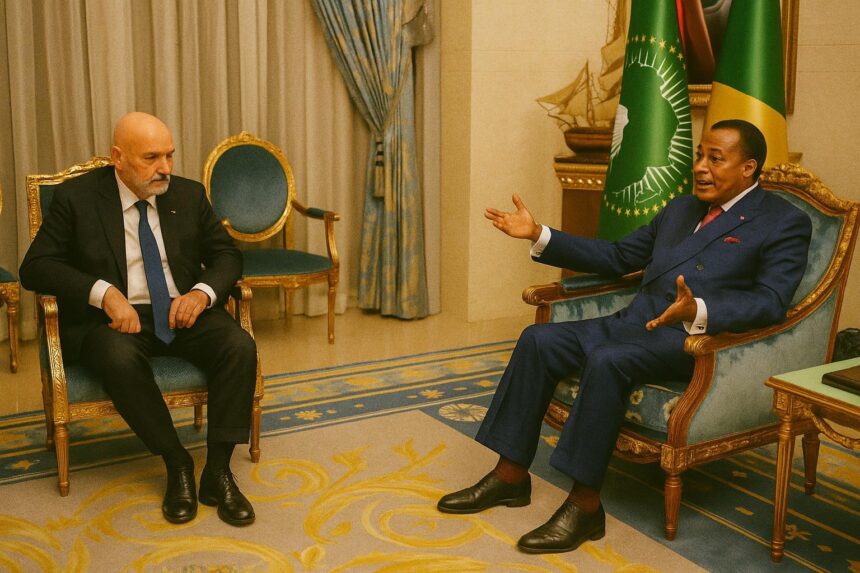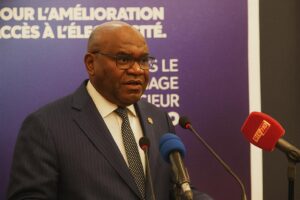Strategic Energy Corridor Revitalised
The dense equatorial forest between the Atlantic port of Pointe-Noire and the capital Brazzaville has long concealed a fragile power artery. This week Claudio Descalzi, the long-serving chief executive of Eni, disclosed that rehabilitation crews have begun upgrading the 220-kilovolt transmission line connecting Djeno to Brazzaville. The line, first commissioned in the 1980s, is essential to evacuate electricity from the gas-fired Centrale Électrique du Congo and to balance regional load flows. Descalzi’s announcement, delivered after an audience with President Denis Sassou Nguesso at the Palais du Peuple, signals the materialisation of an investment dossier discussed for nearly a decade in both ministerial and corporate circles.
Presidential Backing and Regulatory Context
Brazzaville’s leadership has repeatedly highlighted the modernisation of backbone infrastructure as a prerequisite for broad-based growth, and the President’s reception of the Eni delegation underscored executive support. The rehabilitation coincides with the new electricity code adopted in 2022, which encourages public-private partnerships while maintaining strategic state oversight. According to the Ministry of Energy and Hydraulics, peak demand in Brazzaville has risen by 28 percent since 2018, a figure that places persistent stress on ageing conductors and transformers (African Development Bank 2022). By targeting the most congested segment of the grid, the Eni-backed works are expected to reduce technical losses that currently hover near 22 percent, well above the 10 percent threshold advocated by the International Energy Agency for emerging systems (International Energy Agency 2021).
Gas Monetisation and Domestic Supply
Eni’s renewed focus on power transmission is inseparable from its broader gas monetisation strategy. The company has already commissioned Phase One of the Marine XII compressed natural gas project and plans to deliver 4.5 billion cubic metres per year of liquefied gas for export once the second train becomes operational. Yet Descalzi emphasised that associated gas and condensates would be reserved for the domestic market, guaranteeing feedstock for the Djeno combined-cycle plant and future modular units along the corridor. Industry analysts in Paris argue that such dual-track allocation of gas revenues—export earnings on the one hand, secure domestic supply on the other—enhances fiscal resilience at a moment when hydrocarbon prices remain volatile (Reuters 2023).
Agricultural Synergies and Energy Transition
Beyond hydrocarbons, the Italian major has invested in a 50,000-hectare agro-industrial programme in the Bouenza Province, where a recently inaugurated seed-crushing facility produces vegetable oil for sustainable aviation fuel. This horizontal integration, praised by the Congolese Ministry of Agriculture, dovetails with Brazzaville’s ambition to diversify its rural economy without compromising food security. Power reliability along the Djeno–Pointe-Noire–Brazzaville axis will be indispensable for cold-chain logistics, irrigation pumps and small-scale processing units that anchor the emerging biofuel value chain. Development economists at the United Nations Economic Commission for Africa point out that rural electrification reduces post-harvest losses by up to 30 percent, thereby amplifying the developmental multiplier of agro-energy projects (UNECA 2022).
Regional Integration and Diplomatic Implications
The high-voltage line also constitutes a critical segment of the envisaged Central African Power Pool interconnector that would eventually link Cameroon, Gabon and the Democratic Republic of Congo. By upgrading substations and reinforcing pylons to withstand higher thermal loads, Eni is enabling future loop flows that could stabilise frequency across the sub-region. Diplomats stationed in Brazzaville quietly regard the project as a confidence-building instrument, reinforcing Congo-Brazzaville’s reputation as a reliable energy hub at a time when cross-border trade often grapples with logistical bottlenecks. The initiative aligns with the African Union’s Programme for Infrastructure Development in Africa, which prioritises transnational transmission lines to catalyse industrial corridors.
Prospects for Sustainable Electrification
Work crews have already erected temporary gantries near the Kouilou River, and the first batch of low-loss conductors is expected to arrive from a factory in Mantova within weeks. Project managers anticipate that the rehabilitation will be completed ahead of the 2025 African Games, an event the government hopes will showcase the country’s infrastructural renewal. Financial analysts note that a more resilient grid should improve the credit profile of the national utility, opening the door to concessional loans for downstream distribution upgrades. In the longer term, a modern high-voltage spine could accommodate intermittent renewables—solar farms near Kintélé or run-of-river hydropower in the Chaillu Massif—advancing Congo’s nationally determined contributions under the Paris Agreement.
For now, however, the priority remains the swift and disciplined execution of the Djeno–Pointe-Noire–Brazzaville overhaul. As workers anchor new composite insulators under the equatorial sun, the project offers a tangible demonstration of how pragmatic partnerships between the Congolese state and international operators can bridge infrastructure gaps, convert gas wealth into kilowatts and lay the foundations for industrial diversification. In the words of one senior official at the Energy Ministry, “a reliable line is more than metal and electrons; it is the conduit through which our development aspirations can flow unimpeded.”
















